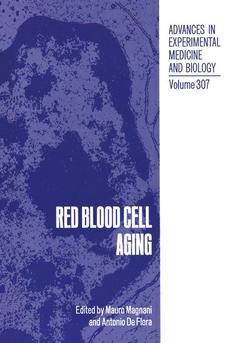Description
Red Blood Cell Aging, Softcover reprint of the original 1st ed. 1991
Advances in Experimental Medicine and Biology Series, Vol. 307
Coordinators: De Flora Antonio, Magnani Mauro
Language: English
Subjects for Red Blood Cell Aging:
Keywords
Publication date: 03-2012
400 p. · 17.8x25.4 cm · Paperback
400 p. · 17.8x25.4 cm · Paperback
Description
/li>Contents
/li>
The mammalian erythrocyte is a very suitable model for the study of aging at the cellular and molecular level. It is not only a matter of apparent simplicity in terms of biochemistry, biophysics and physiology but more likely this cell offers a great possibility for elucidating some basic problems in the process of aging. In fact, nowadays, it is possible to follow individual cells all along their life span in circulation, it is possible to obtain these cells when young, middle aged or old and it is possible to obtain cells from individuals of defined ages and transfuse them into compatible recipients to investigate the role of the environment where the cell lives, and finally it is possible to easily manipulate the red cell content in terms of enzymatic activities and/or metabolic properties to investigate the possible effect of these manipulations on cell survival. This book, Red Blood Cell Aging, is based on a symposium held in Urbino, Italy, at the end of 1990 and examines the impact of age on the membrane, metabolism, structural and enzymatic proteins of mammalian erythrocytes. The various contributions to this symposium not only described those processes of aging which affect the cell but also provided a nearly complete picture of the event{s} and mechanism{s} that every day permits to recognize among 25 trillion circulating red cells {in an average adult} that 1 percent that have reached the end of their 120 day life span in circulation.
Reticulocyte Maturation.- Synthesis of the Transferrin Receptor in Peripheral Sheep Reticulocytes: Evidence for Incomplete Oligosaccharide Processing.- The Loss of Enzyme Activity from Erythroid Cells During Maturation.- Role and Mechanism of Hexokinase Decay During Reticulocyte Maturation and Cell Aging.- Behaviour of Glucose-6-Phosphate Dehydrogenase During Erythroid Maturation.- Membranes.- KCl Cotransport in HbAA and HbSS Red Cells: Activation by Intracellular Acidity and Disappearance During Maturation.- Conformational Changes and Oxidation of Membrane Proteins in Senescent Human Erythrocytes.- Selective Binding of Met-Hemoglobin to Erythrocytic Membrane: A Possible Involvement in Red Blood Cell Aging.- Diabetes Mellitus and Red Blood Cell Aging: A Structural and Functional Study.- Metabolism.- Characterization of Senescent Red Cells from the Rabbit.- The Mechanism of Enzyme Decline in the Red Blood Cell During the “In Vivo” Aging Process.- The Relationship Between the Blood Oxygen Transport and the Human Red Cell Aging Process.- Red Cell Metabolism, Normal and Abnormal Implications for Red Cell Aging.- Significance and Relevance of NAD Synthesis in Human Erythrocyte Life Span.- Protein Modifications.- Hypotheses on the Physiological Role of Enzymatic Protein Methyl Esterification Using Human Erythrocytes as a Model System.- Heterogeneity of Guanine Nucleotide Binding Proteins in Human Red Blood Cell Membranes.- Role of Hemoglobin Denaturation and Band 3 Clustering in Initiating Red Cell Removal.- A Potential, Intracellular Trigger for Removal of Senescent Erythrocyte: Hemoglobin with Methionine Beta (55)D6 Oxidized to the Sulfoxide Derivative.- Ubiquitin-Mediated Processes in Erythroid Cell Maturation.- Acylphosphatase and Calcium Transport Across ErythrocyteMembrane.- Free Radicals Promote “In Vitro” a Different Intracellular Decay of Rabbit Reticulocyte and Erythrocyte Glycolytic Enzymes.- Enzymology.- Clinical Utility of Fractionating Erythrocytes into “Percoll” Density Gradients.- The Role of Red Cell Aging in the Diagnosis of Glycolytic Enzyme Defects.- Molecular Characterization of Plasma Membrane Calcium Pump Isoforms.- Human Erythrocyte D-Aspartyl/L-Isoaspartyl Methyltransferases: Enzymes that Recognize Age-Damaged Proteins.- The Isoenzymes of Mammalian Hexokinase: Tissue Specificity and In Vivo Decline.- Phagocytosis of Phenylhydrazine Oxidized and G-6-PD deficient Red Blood Cells: The Role of Sugars and Cell-Bound Immunoglobulins.- The Senescent Red Cell and its Removal.- Molecular Mapping of the Active Site of an Aging Antigen.- Recognition Signals for Phagocytic Removal of Favic Malaria-Infected and Sickled Erythrocytes.- Inhibition by Carbohydrates and Monoclonal Anticomplement Receptor Type 1, on Interactions between Senescent Human Red Blood Cells and Monocytic Macrophagic Cells.- In Vitro Sequestration of Erythrocytes from Hosts of Various Ages.- A New Monoclonal Antibody to an Age Sensitive Band 3 Transmembrane Segment.- Characterization of Antibody that Binds in Vivo to Normal Human Red Blood cells.- Opsonic Potential of C3b-Anti-Band 3 Complexes When Generated on Senescent and Oxidatively Stressed Red Cells or in Fluid Phase.- Contributors.
© 2024 LAVOISIER S.A.S.




